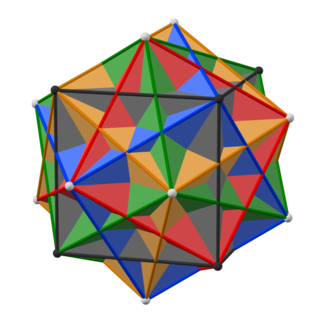In mathematics
1728 is the cube of 12, [2] and therefore equal to the product of the six divisors of 12 (1, 2, 3, 4, 6, 12). [3] It is also the product of the first four composite numbers (4, 6, 8, and 9), which makes it a compositorial. [4] As a cubic perfect power, [5] it is also a highly powerful number that has a record value (18) between the product of the exponents (3 and 6) in its prime factorization. [6] [7]
It is also a Jordan–Pólya number such that it is a product of factorials: . [8] [9]
1728 has twenty-eight divisors, which is a perfect count (as with 12, with six divisors). It also has a Euler totient of 576 or 242, which divides 1728 thrice over. [10]
1728 is an abundant and semiperfect number, as it is smaller than the sum of its proper divisors yet equal to the sum of a subset of its proper divisors. [11] [12]
It is a practical number as each smaller number is the sum of distinct divisors of 1728, [13] and an integer-perfect number where its divisors can be partitioned into two disjoint sets with equal sum. [14]
1728 is 3-smooth, since its only distinct prime factors are 2 and 3. [15] This also makes 1728 a regular number [16] which are most useful in the context of powers of 60, the smallest number with twelve divisors: [17]
- .
1728 is also an untouchable number since there is no number whose sum of proper divisors is 1728. [18]
Many relevant calculations involving 1728 are computed in the duodecimal number system, in-which it is represented as "1000".
Modular j-invariant
1728 occurs in the algebraic formula for the j-invariant of an elliptic curve, as a function over a complex variable on the upper half-plane , [19]
- .
Inputting a value of for , where is the imaginary number, yields another cubic integer:
- .
In moonshine theory, the first few terms in the Fourier q-expansion of the normalized j-invariant exapand as, [20]
The Griess algebra (which contains the friendly giant as its automorphism group) and all subsequent graded parts of its infinite-dimensional moonshine module hold dimensional representations whose values are the Fourier coefficients in this q-expansion.
Other properties
The number of directed open knight's tours in minichess is 1728. [21]
1728 is one less than the first taxicab or Hardy–Ramanujan number 1729, which is the smallest number that can be expressed as sums of two positive cubes in two ways. [22]











